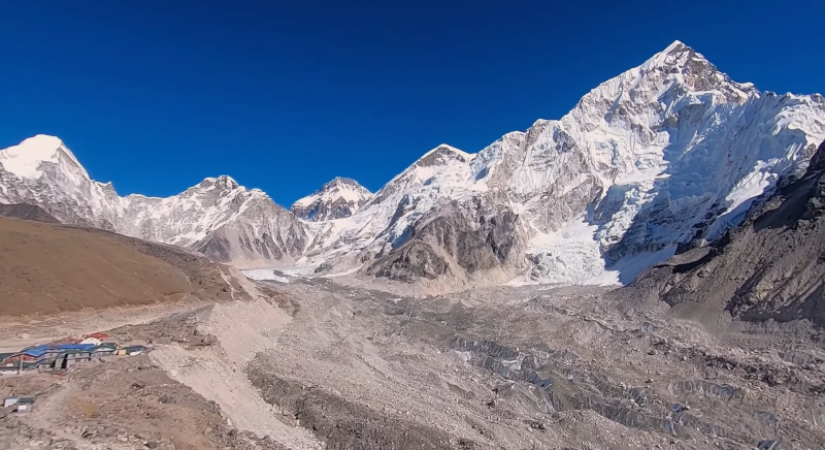Embarking on a trekking journey from Kathmandu to Everest is more than just a physical challenge; it is an epic adventure that intertwines breathtaking landscapes, rich cultural experiences, and a profound sense of personal accomplishment. The journey begins in Kathmandu, Nepal’s bustling capital, where ancient temples and vibrant markets set the stage for an unforgettable odyssey. The city itself is a kaleidoscope of sights, sounds, and smells, offering a fascinating introduction to Nepalese culture and history.
As the trek unfolds, the journey transitions from the urban vibrancy of Kathmandu to the serene and majestic beauty of the Himalayas. The initial leg of the trek takes you through lush terraced fields and quaint villages, where traditional Nepalese life continues unchanged. Each village you pass is a living snapshot of local culture, with friendly residents who offer warm hospitality and share insights into their way of life.
The trek to Everest Base Camp, often referred to as the “Ultimate Trekking Journey,” is not just about reaching a destination; it’s about the journey itself. As you ascend, the terrain changes dramatically. The verdant landscapes give way to rugged mountain paths, and the air grows thinner with each step. The trekker’s spirit is tested by the challenging altitudes and ever-changing weather, but the rewards are unparalleled. The path to Everest offers stunning vistas of the Himalayas, with views of peaks like Lhotse, Nuptse, and, of course, the mighty Everest, standing tall as the ultimate prize.
Throughout the journey, you’ll traverse through various altitudes, each bringing its own unique set of scenery and challenges. The trek involves crossing numerous suspension bridges over roaring rivers, navigating rocky trails, and experiencing the raw power of nature. The higher you climb, the more dramatic the landscape becomes, with the snow-capped peaks and glaciers painting a picture of pristine beauty against the deep blue sky.
Reaching Everest Base Camp is a monumental achievement for any trekker. Standing at the foot of the world’s highest peak, the sense of accomplishment and awe is immense. The base camp itself is a hive of activity, with climbers, trekkers, and mountaineers from around the world converging to prepare for their own high-altitude endeavors. The camp serves as a testament to human endurance and a hub of stories and dreams.
The return journey to Kathmandu offers a time for reflection. As you descend, the familiar landscape of terraced fields and vibrant villages reappears, providing a gentle reintroduction to the more tranquil aspects of Nepalese life. The trek from Kathmandu to Everest is a journey of contrasts, from the bustling streets of the capital to the serene solitude of the Himalayas. It is a pilgrimage that challenges the body and enriches the soul, leaving trekkers with memories and a sense of fulfillment that lasts a lifetime.
Introduction to the Trekking Journey
Embarking on a trek from Kathmandu to Everest Base Camp Trek cost is a profound adventure that offers not only the challenge of high-altitude hiking but also a deep dive into Nepal’s stunning natural beauty and rich cultural heritage. Starting in Kathmandu, Nepal’s vibrant capital, trekkers are immediately immersed in the city’s bustling energy, where ancient temples, colorful markets, and a blend of traditional and modern influences create a captivating backdrop. This introduction to Nepal sets the stage for the journey ahead. As trekkers leave behind the urban environment, the trek unfolds through diverse landscapes, from lush valleys to the rugged terrain of the Himalayas. The trek to Everest Base Camp is renowned for its awe-inspiring vistas and the sense of accomplishment that comes with reaching one of the most iconic destinations on Earth. It is not merely a physical journey but also an emotional and spiritual one, offering moments of introspection amidst the grandeur of the world’s highest peaks.
Preparing for the Journey
Preparation is key to ensuring a successful and enjoyable trek to Everest Base Camp. Adequate physical conditioning is essential, as the trek involves significant elevation gain and varying weather conditions. Prospective trekkers should engage in regular cardiovascular and strength training exercises, focusing on endurance and leg strength. Gear preparation is equally crucial, including investing in quality trekking boots, thermal clothing, and a good sleeping bag suited for high-altitude conditions. It is also important to familiarize oneself with altitude sickness symptoms and acclimatization strategies. Additionally, securing necessary permits, such as the Sagarmatha National Park entry permit and TIMS card, is required. Arranging travel insurance that covers high-altitude trekking can provide peace of mind. Finally, researching the local customs and culture enhances the trekking experience, allowing trekkers to engage respectfully with the communities they encounter.
Traveling from Kathmandu to Lukla
The journey from Kathmandu to Lukla marks the beginning of the trekking adventure and is an experience in itself. Lukla, the gateway to the Everest region, is accessible via a thrilling flight from Kathmandu’s Tribhuvan International Airport. The flight, renowned for its breathtaking views of the Himalayas and its notoriously short, challenging runway, is both exhilarating and scenic. As the plane descends into Lukla, trekkers are greeted with the first glimpses of the mountainous landscape that awaits. The airport in Lukla is one of the highest in the world, and the transition from the bustling city to this serene mountain environment is immediate. Once in Lukla, trekkers begin their journey through the Khumbu region, moving from the small yet lively town into the surrounding wilderness, marking the start of an incredible trekking experience.
Trekking Routes Overview
The trek to Everest Base Camp follows a well-established route that offers a variety of experiences, from lush valleys to high-altitude landscapes. The trek typically begins in Lukla and progresses through several distinct phases. The initial section leads through the verdant Phakding Valley, gradually ascending to Namche Bazaar, a bustling Sherpa town known for its market and acclimatization opportunities. From Namche, the route continues through Tengboche, renowned for its beautiful monastery and panoramic views of Everest and its neighboring peaks. The trek then moves through Dingboche and Lobuche, each offering unique perspectives of the towering Himalayas. Finally, trekkers reach Gorak Shep before the final push to Everest Base Camp. This route provides a comprehensive experience of the diverse environments and cultures of the Khumbu region, culminating in the iconic arrival at the base of the world’s highest peak.
Key Stops along the Trek
The Everest Base Camp Itinerary features several key stops that enrich the journey with cultural and scenic highlights. Namche Bazaar is a central hub for acclimatization and offers stunning views of the surrounding peaks, including Everest. Tengboche is notable for its ancient monastery and panoramic vistas of the Himalayas. Dingboche provides an excellent opportunity for acclimatization while offering incredible views of the nearby Ama Dablam and other peaks. Lobuche is a crucial stop before the final ascent to Everest Base Camp, offering a last chance to prepare for the high-altitude environment. Each of these stops not only offers essential services and accommodations but also allows trekkers to immerse themselves in the local culture and enjoy spectacular mountain scenery, making the journey to Everest Base Camp a richly rewarding experience.
Acclimatization Techniques
Acclimatization is a crucial aspect of trekking to Everest Base Camp, essential for preventing altitude sickness and ensuring a safe journey. The key to successful acclimatization lies in gradually ascending to higher altitudes and allowing the body adequate time to adjust. A common approach is the “climb high, sleep low” strategy, where trekkers ascend to higher altitudes during the day but return to a lower elevation to sleep. This technique helps the body adapt to the reduced oxygen levels gradually. Ensuring proper hydration and maintaining a balanced diet rich in carbohydrates also supports the acclimatization process. Taking rest days, particularly in key locations like Namche Bazaar and Dingboche, allows for necessary physical adjustment and reduces the risk of altitude-related illnesses. Additionally, it’s vital for trekkers to be aware of the symptoms of altitude sickness, such as headaches, nausea, and dizziness, and to seek medical attention promptly if symptoms arise. Adequate acclimatization not only enhances comfort but also significantly contributes to the overall safety and enjoyment of the trek.
Essential Gear and Supplies
Proper gear and supplies are fundamental for a successful trek to Everest Base Camp. Trekking boots with good ankle support and traction are essential for navigating varied terrain. Layered clothing, including moisture-wicking base layers, insulating mid-layers, and a waterproof outer layer, is crucial for managing temperature fluctuations and weather conditions. A high-quality sleeping bag rated for sub-zero temperatures is necessary for the cold nights at higher altitudes. Additionally, trekking poles can provide stability and reduce strain on the knees during steep ascents and descents. Other important items include a durable backpack, a hydration system or water bottles, high-energy snacks, and personal medications. It’s also advisable to carry a first aid kit, a headlamp with extra batteries, and sunscreen to protect against the strong UV rays at high altitudes. Properly packing and maintaining these essentials ensures both comfort and safety throughout the trek.
Navigating the Terrain
Navigating the terrain on the trek to Everest Base Camp involves traversing a variety of landscapes, each presenting its own challenges. The trek begins with a relatively gentle ascent from Lukla through lush valleys and terraced fields. As the trek progresses, the terrain becomes increasingly rugged and steep. Navigating rocky paths, suspension bridges over rushing rivers, and narrow mountain trails requires careful attention and steady footing. Trekking poles can be invaluable in maintaining balance and reducing impact on the knees. It’s also essential to be prepared for variable weather conditions, including sudden snowfall and fog, which can obscure trails and make navigation more difficult. Familiarizing oneself with the route and carrying a detailed map or GPS device can help with orientation and prevent getting lost. Employing local guides or porters, who are well-versed in the region’s terrain, can also enhance safety and navigation efficiency.
Cultural Experiences on the Trek
The trek to Everest Base Camp is rich with cultural experiences that offer deep insights into the traditions and lifestyles of the Sherpa people. As trekkers move through the Khumbu region, they encounter traditional Sherpa villages, where the vibrant culture is evident in daily life and customs. In Namche Bazaar, trekkers can visit local markets and interact with Sherpas, gaining insights into their way of life. Tengboche, with its renowned monastery, provides a glimpse into Tibetan Buddhism through its ceremonies and rituals. Villages like Dingboche and Lobuche offer opportunities to experience Sherpa hospitality and learn about their customs. The trek also passes through ancient chortens (stupas) and prayer flags that add to the spiritual ambiance. Engaging with local communities, participating in cultural ceremonies, and learning about their traditions enhance the trekker’s experience and provide a richer understanding of the region’s heritage.
Health and Safety Considerations
Health and safety are paramount on the 15 Day trek to Everest Base Camp due to the challenging conditions and high altitudes. Altitude sickness is a primary concern, with symptoms including headaches, nausea, and dizziness. To mitigate risks, it’s important to follow acclimatization protocols, stay hydrated, and maintain a gradual pace. Trekkers should also be aware of signs of more severe conditions, such as High Altitude Pulmonary Edema (HAPE) or High Altitude Cerebral Edema (HACE), which require immediate medical attention. Carrying a comprehensive first aid kit and knowing basic first aid procedures can be crucial. Ensuring proper hygiene to avoid gastrointestinal issues and having a reliable communication device for emergencies is also important. It’s advisable to have travel insurance that covers high-altitude trekking and emergency evacuation. Being prepared for the potential health and safety challenges of the trek ensures a safer and more enjoyable journey to Everest Base Camp.
Accommodation Options
Accommodation on the trek to Everest Base Camp primarily consists of teahouses, which are lodges offering basic amenities and a cozy respite from the challenging trek. These teahouses are scattered along the route and provide a range of options from simple rooms with shared facilities to more comfortable accommodations with private rooms and attached bathrooms. In bustling towns like Namche Bazaar, you’ll find more developed lodgings with additional comforts and services. As you ascend to higher altitudes, the teahouses become more basic, focusing on providing essential services such as heating and warm meals to help trekkers cope with the cold. Booking in advance is not always necessary, but during peak trekking seasons, it can be beneficial to secure accommodations to avoid any last-minute hassles. While teahouses offer a good level of comfort, trekkers should be prepared for communal living and basic facilities. The hospitality and warmth of the local hosts often make these stays memorable and provide an authentic glimpse into the Sherpa way of life.
Food and Nutrition Tips
Maintaining proper nutrition is essential for sustaining energy and health during the trek to Everest Base Camp. The teahouses along the route typically offer a variety of meals, including traditional Nepalese dishes such as dal bhat (lentil soup with rice), momo (dumplings), and noodles. These meals are often rich in carbohydrates, which are crucial for endurance and energy. It’s important to stay hydrated, especially at higher altitudes where dehydration is common. Drinking plenty of water and consuming electrolyte-rich fluids can help prevent altitude sickness. Carrying high-energy snacks like nuts, trail mix, and energy bars can provide quick boosts of energy during long trekking days. Additionally, be cautious about food hygiene to avoid gastrointestinal issues; opt for cooked foods and bottled or treated water. Balancing your diet with fruits, vegetables, and proteins, when available, helps maintain overall health and stamina. Proper nutrition supports both physical performance and acclimatization, ensuring a more enjoyable trekking experience.
Photography and Capturing Memories
Capturing the stunning landscapes and unique moments of the trek to Everest Base Camp is a rewarding part of the journey. The dramatic vistas of snow-capped peaks, lush valleys, and traditional Sherpa villages offer ample opportunities for memorable photographs. It’s advisable to carry a reliable camera with extra batteries and memory cards, as cold weather can deplete battery life more quickly. A smartphone with a good camera can also be useful for spontaneous shots. When photographing, be mindful of the lighting conditions, which can change rapidly in mountainous environments. Early mornings and late afternoons often provide the best light for capturing landscapes. Respect the local culture and people by asking permission before taking photos, especially in sacred or private areas. Additionally, using a lightweight tripod can help with low-light photography and capturing clear, stable images. Documenting your trek with photos not only preserves the memories but also allows you to share your adventure with others.
Environmental Responsibility
Environmental responsibility is crucial when trekking to Everest Base Camp to preserve the natural beauty and integrity of the Himalayas. Trekkers should adhere to the principle of “Leave No Trace,” which includes packing out all waste, including non-biodegradable items like plastics and batteries. Utilizing eco-friendly practices, such as minimizing the use of disposable products and opting for biodegradable soap, helps reduce environmental impact. Many teahouses and local organizations promote waste management and conservation efforts; participating in these initiatives can contribute positively to the region. Additionally, respecting wildlife and natural habitats by avoiding disturbances and not feeding animals supports the local ecosystem. Educating oneself about the environmental challenges faced by the Everest region, such as glacial melting and pollution, can further enhance awareness and encourage responsible trekking practices. By committing to environmental stewardship, trekkers help ensure that the beauty of the Everest region is preserved for future generations.
Conclusion and Next Steps
Completing the trek to Everest Base Camp is a significant achievement that offers not only personal satisfaction but also a profound connection to one of the world’s most iconic landscapes. As you reach the base camp and take in the awe-inspiring views of Everest, it’s an opportunity to reflect on the journey’s challenges and triumphs. The experiences gained—from the physical demands to the cultural encounters—are invaluable. After completing the trek, consider taking some time to explore Kathmandu further, visiting local landmarks, and enjoying the city’s vibrant atmosphere. Reflecting on your adventure through journal entries or sharing stories with fellow trekkers can also be fulfilling. If you’re inspired to continue exploring, consider other treks in Nepal or other regions with similar natural and cultural richness. Planning for future adventures with the knowledge and skills gained from the Everest trek can lead to more rewarding experiences. Ultimately, the trek to Everest Base Camp is not just about reaching a destination but embracing a journey that enriches your life and leaves lasting memories.



